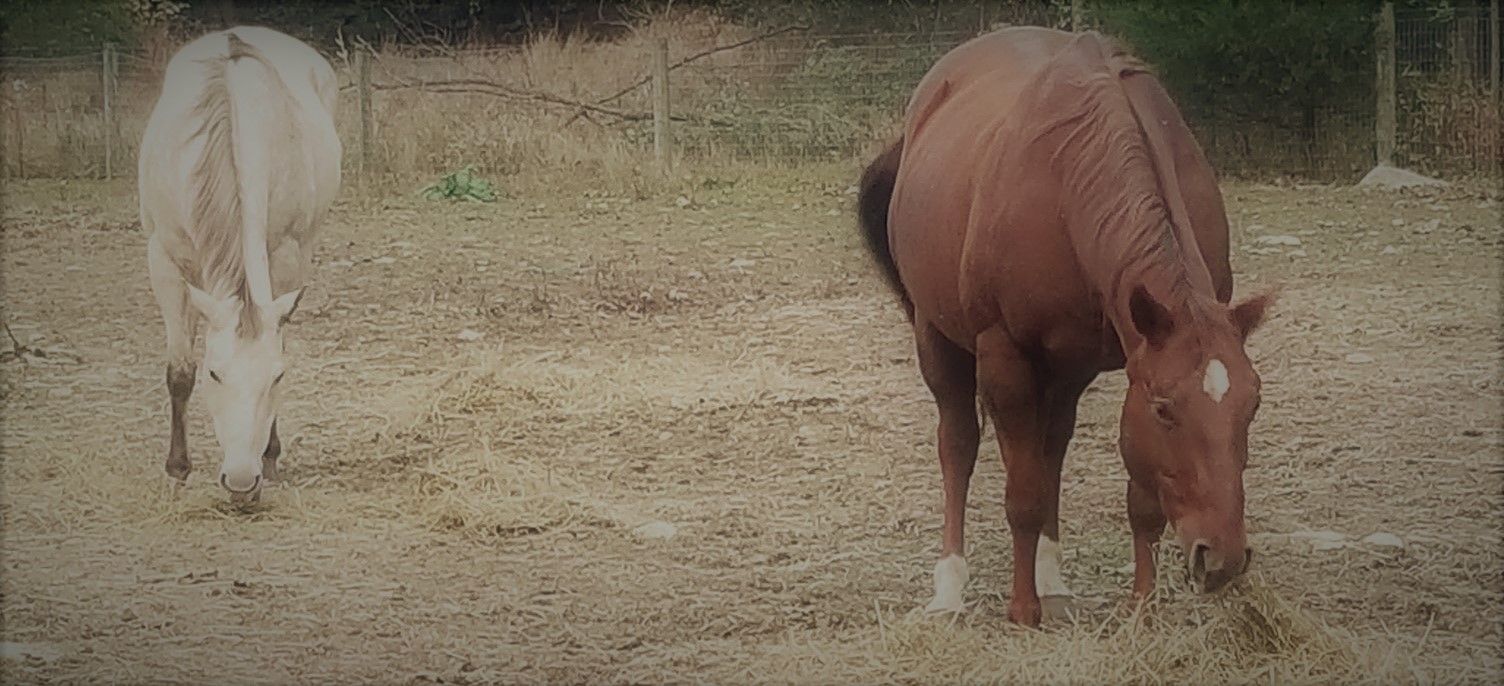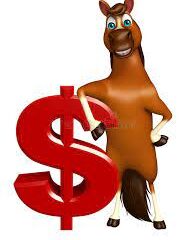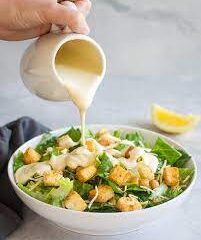Feeding The Metabolic Horse

This is a subject that is close to my heart since Flair fought bouts of laminitis and abscesses for 16 months from August 2016 to December 2017 so I had a crash course in equine nutrition for horses suffering from metabolic conditions.
The bad news about EMS is that there are few reliable tests and very subtle warning signs that your horse may be suffering from a metabolic condition.
The good news is that the entire feed industry has mobilized to fill the needs in this market. This gives us plenty of options to use in addressing this devastating condition.
EMS 101 Abridged
There are books written and being written about metabolic conditions in horses.
In a nutshell, Equine Metabolic Syndrome and Cushing’s although having different causes both share the same condition; the inability to efficiently process glucose in the blood. This condition, much like diabetes in humans, causes changes to the vascular system which manifest as everything bad does for horses, in their hooves. Painful abscesses, laminitis and the subsequent reconfiguration of the hoof capsule and bone structure within are all consequences of this condition.
For some added perspective EMS was not even identified and adopted as a condition until 2011. Until that time these horses were branded “easy keepers”, shod, given a double dose of NSAID and sent to the auction to become someone else’s problem.
Flair began giving me the subtle signs back in 2009. Random mild lameness in the foot, low level heat, subsolar abscesses three or four times a year were all warning signs. Even the best veterinarians shrugged their shoulders and scratched their heads back then. It wasn’t until 2016 when she blew abscesses in all four feet that we figured out what the trouble really was.
Non Structural Carbohydrates
The big focus for metabolic horses is NSC. Non Structural Carbohydrates are the non structural parts of plants, basically the soft stuff inside the hard shell of the leaf. NSC is highly digestible and that’s why it causes so much trouble for horses whose metabolism prevents insulin from doing its job of processing glucose in the blood.
Everyone understands the role NSC plays in causing a horse to become symptomatic. Unfortunately many people don’t understand managing Non Structural Carbohydrates.
Please believe me when I tell you I understand the desire to eliminate all NSC from your horse’s diet while you are witnessing the horror of a horse who will not even try to stand to eat their meal. I experienced this nightmare first hand so I get it. We need to take a breath and follow the science.
The Magic NSC Number is NOT 11%
Over the years I think I’ve explained this whole thing about a million times so this will be a million and one. My inaugural video for the new youtube channel will be a visual representation of this concept and hopefully that will fix things.
Horses do not eat percentages, they eat a certain weight of feed that includes a certain weight of NSC as a percentage of the total weight.
The 11% target was part of the first set of feeding protocols before we had more research to call upon and it was associated with FORAGE. NSC content is more significant in forage because a horse consumes so much of it. We will cover how to handle forage in a bit.
It’s frustrating for a feed specialist to hear a customer with a newly diagnosed horse ask me for feed with less than 11% NSC. It’s even more frustrating when they ask for a specific feed because the website says the feed is under 11% NSC but it’s not listed on the GA. We’ll get to that too.
What is the “Triggering Factor”?
In a 2016 study Cooperative Research Farms determined that one pound of NSC is the max tolerable limit for diagnosed insulin resistant horses in a six hour feed interval.
Like a human diabetic it isn’t just the total NSC consumed but the rate of consumption. The metabolism of a normal horse will do a better job of keeping up with a high rate of NSC consumption while a compromised horse cannot.
There are many “moving parts” to managing these conditions outside of diet. Overall weight, body condition, adipose fat and exercise all play a role in when bad things are going to happen. In another similarity to humans Insulin Resistance in EMS horses (as opposed to PPID) is largely caused by obesity and lack of exercise.
Age is also a factor. A horse’s metabolism will change when they hit middle age which is why most initial EMS diagnoses happen between age 12 and 14.
My advice to all my clients is to treat every horse as if they had a metabolic condition. Low starch diet, maintain a good weight and plenty of exercise. If your horse is “normal” how is this a bad formula?
Feeding the Metabolic Horse and “Easy Keepers”
I included easy keepers in this section because the feeding strategies are identical. Control calories and NSC.
Many easy keepers are obese but not metabolic and many metabolic horses are obese but not all.
There are three components to any equine feed program; Forage, Feed and…TREATS. The key to success is to control and moderate the delivery of nutrition sources.
Forage
I want to start with forage because it should make up the majority of a horse’s diet. Remember the part about 11% NSC being most applicable to forage? Pay attention.
We’re not going to include pasture in this conversation because if you are feeding an obese or metabolic horse pasture should not be on the menu without restriction.
Our unicorn (1,000 pound horse) will ideally consume 15 pounds of hay in a day. A NSC level of 11% yields roughly 1.7 pounds of NSC in a day. If we divide this into four six hour feed intervals you are easily below the “safe” NSC level of one pound.
If your horse is like most and you plunk a half a day’s worth of hay in their field they will gobble that 7.5 pounds in about an hour. That’s going to put you near the danger zone and not leave much room for the NSC in feed.
Slow feed nets are your friend. I suggest investing in really expensive and durable slow feed bags because they will do more for controlling NSC for your horse than 11% horse feed. Slow feed nets will also help with ulcers and behavior issues.
When buying hay in large quantities of hay it may be practical to have the hay tested but if it comes back at 14% NSC what do you do with the 500 bales you have jacked in the loft?
My suggestion is to find mature, first cutting grass hay. It should be a little stemmy with large fully formed seed heads. Based on the scores of hay analyses I’ve read this type of hay will with few exceptions be well UNDER 11% NSC.
Later cuttings of hay will almost always be MUCH higher than 11% and should be avoided.
Soaking is an option but it’s messy and time consuming. Soaking hay for 30 minutes in cold water will reduce NSC by around 15%. It will also wash out many nutrients but we will be supplementing with a balancer so that’s no problem.
I recommend soaking hay if your horse is recently diagnosed and is having issues with laminitis. Soaking is also helpful for weight loss since it will rinse out 15% of the calories.
Stemmy, mature hay also acts as a natural slow feed system because they will have to eat around the big stuff to get to the tasty leaves. You may have to feed 20 pounds per day instead of 15 to make up for the waste.
Teff hay is becoming more popular and is low in NSC. Some hay farmers are testing hay and will guarantee NSC levels. It will cost more but if you’re losing sleep…
Alfalfa is naturally very low in NSC but it is very high in calories and highly palatable. There is also some evidence that highly excessive protein consumption can trigger laminitis. You would need to feed 20 pound per day to come close to the trigger point but it is a consideration.
Alfalfa comes in handy when your metabolic horse may begin to be a hard keeper in advanced age.
Beet pulp is the forgotten forage. It’s great for IR horses because NSC averages under 12% with low protein, good calories and highly digestible fiber.
Plenty of dry lot turnout and controlled delivery of forage is essential to success in managing these horses.
Feed
Alrighty then, I’m ready for a fight on this subject from everyone who has been convinced that all feed for metabolic horses must be below 11%, which is almost impossible by the way.
Let me begin by stating clearly that if you have a metabolic horse, any horse, really but certainly a metabolic horse you should NOT feed any feed that does not clearly display starch and sugar in the guaranteed analysis on their feed tag. If they put NSC on the feed tag it doesn’t count. Sugar and starch are the only nutrients tested for by regulatory agencies and only if they are included in the GA.
We can determine NSC by adding the sugar value to the starch value with the result being total NSC. You will note that these values are listed as MAX. This is significant because feed makers that list these values will shoot for around 85% in their formula so the actual NSC is probably lower.
Nothing frustrates me more than an owner who will soak every stalk of hay but is feeding a feed that is the lowest NSC possible because that’s what is listed on their website. I digress.
Choosing a feed for these horses is usually easy. Since they are probably overweight we will choose a ration balancer. A ration balancer will provide all essential nutrition with minimal calories and NSC.
I will use Purina Enrich as an example. On the guaranteed analysis Purina shows starch as 5% MAX and sugar at 10% MAX for a total NSC of 15%. Enrich is fed at a rate of 1 pound per day for a 1,000 pound horse. If we break that up into two 8 ounce servings we will be feeding our horse only 1.2 ounces of NSC per meal. That leaves us a 14.8 ounce margin for our forage component. 11% of 7.5 pounds is 13.2 ounces so we are way safe. Remember that the second feed interval has no feed, only forage so the glycemic response index will moderate even further. If your hay is down around 8% NSC it’s even better.
How about when we are working hard and the horse requires more concentrated calories? I’ll use Purina again since I have their reference material handy and I’m lazy.
Purina Ultium Competition yields a massive 1,900 calories per pound in digestible energy with only 16% NSC (sugar + starch listed on the GA).
The minimum daily feed rate for this feed is three pounds for a 1,000 pound horse. If we feed a meal of 1.5 pounds at 16% NSC we net a hair under 4 ounces. If we add in our forage for the interval we are a hair over our limit of a pound of NSC. That’s assuming 11% NSC in our hay so if it’s lower we’re safe. The glucose bell curve will be coming down after about two hours so you are still probably safe.
Assuming we want to be absolutely certain that our horse is safe and symptom free the solution is to break the three pounds up into three meals of one pound each which will absolutely put you into the safe zone. This is a key feed strategy if you have a metabolic horse that is a challenge to maintain weight. Frequent small meals.
One more example and we will keep it in Purina. Purina Wellsove Low Starch is 11% NSC and it is a great feed. So to the nicel lady from Oklahoma who called Purina to tell them I was trying to intentionally kill metabolic horses with this example I hope you’re reading this again.
Wellsolve L/S is an ostensibly “safe” feed at only 11% NSC. However, it only yields 1,200 calories per pound versus the Ultium Competition at 1,900 so if we are trying to meet calorie requirements from workload we have to feed more Wellsolve than Ultium. Almost another pound of Wellsolve is necessary to achieve the same digestible energy as Ultium for a total of 2.4 pounds. This nets us….are you ready? The EXACT SAME AMOUNT OF NSC AT 4.2 ounces!
I hope it worked this time, I’m exhausted.
Treats
Apples, carrots, peppermints, bananas, candy canes are POISON for any horse and lethal for diagnosed metabolic horses. Stop feeding these treats immediately.
When I walk into a feed room and see a five pound bag of apples I have to diligently remind myself that the owner is a customer and slapping them would be bad.
There are low starch treats available with guaranteed NSC on the bag.
Peanuts in the shell are great treats. Some horses have to acquire a taste for them but high in fiber and omegas while being low in sugar make them perfect treats.
Alfalfa cubes peel into pieces like miniature bales of hay. Perfect.
Beet pulp pellets are great treats.
I’d like to appeal to every owner reading this. Save yourself the heartbreak, agony and sleepless nights not to mention the all consuming guilt you will have if your horse crashes with laminitis.
This is tough love time.
Every Situation Calls for Different Protocols
When a horse is experiencing a full blown laminitic episode reducing NSC to the lowest possible level is essential to alleviate their pain. I would soak hay even if it had a low NSC value. This will reduce the NSC as well as the calories since we want to begin the weight loss process.
Keeping a balancer in their diet is important since the horse will need the protein and essential nutrients to fight the laminitis.
It is also important not to “starve” the horse. Although we are anxious to reduce weight forcing our horse to call upon fat reserves to sustain themselves will cause problems. Glucose is stored in fat and when the body begins tapping those fat reserves glucose will be released as well.
Once a horse is stabilized and at a good weight diligence in NSC is not as crucial. You can’t begin feeding apples and second cutting hay but you can probably stop soaking hay and be less concerned about NSC in the feed.


